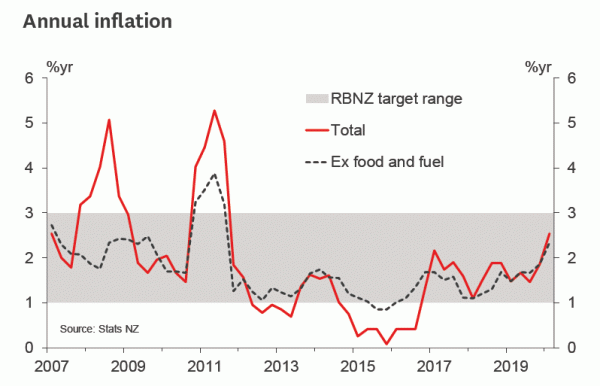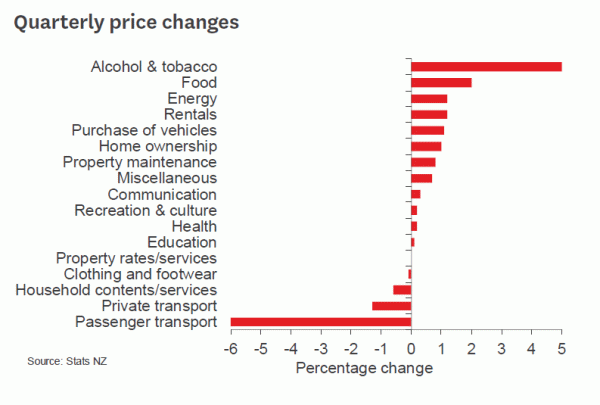CPI Rose 0.8% In March Quarter, Annual Inflation 2.5%.
- Consumer prices rose by 0.8% in the March quarter, more than we and the market expected.
- There were larger than expected increases in cigarette prices, rents and accommodation, and a smaller than usual seasonal drop in airfares.
- The jump in the annual inflation rate will be short-lived. A sharp fall in fuel prices is likely to drag the CPI down in the June quarter.
- Looking ahead, the Covid-19 outbreak represents a shock to both demand and productivity, which could result in lower prices in some areas and higher prices in others.
- But on balance, we expect inflation to be weak over the next couple of years.
Consumer prices rose by twice as much as we and the market forecast in the March quarter, an unusually large ‘miss’ for this series. At any other time this would have been a major development for the Reserve Bank, with annual inflation moving into the upper half of its target range. However, the incredible disruptions resulting from the Covid-19 pandemic mean that this spike in inflation is likely to be short-lived. Indeed, we expect that further monetary easing, in the form of expanded bond purchases, will be needed to keep inflation on track over the next couple of years.
The biggest contributors to the March quarter increase in the CPI were food and tobacco prices. As expected food prices rose by around 2%, more than the usual seasonal increase. Higher international prices for meat and dairy products flowed through to local prices this quarter.
Tobacco prices rose by 11%, broadly matching the annual increase in tobacco excise duty (note that this is the last of the big scheduled increases in excise). This was more than we expected, and was the single biggest miss for our forecast. Last year, a similar-sized increase in tobacco excise yielded just a 9% rise in cigarette prices, with suggestions that prices had reached a ‘pain point’ for buyers. But that didn’t prove to be the case this year.
Rents, which make up almost 10% of the CPI, were another major upside surprise for us. The quarterly index rose by 1.2%, whereas the monthly index had signalled only a 0.9% rise. Prices for newly-built homes were also a little stronger than we forecast, though we did expect them to pick up in line with the re-acceleration in house sale prices over the last year.
The biggest price decline in the March quarter was passenger transport, with domestic airfares down 1.2% and international airfares down 13%. However, these were both less than their usual seasonal declines. In the early phase of the Covid-19 outbreak we saw some discounting by airlines in an attempt to fill planes up. But that’s now changed: the number of flights has been drastically cut back, planes are running at a fraction of their capacity, and those airfares that are available aren’t cheap.
Looking ahead, today’s pop higher in inflation is likely to be swiftly reversed. We recently revised our June quarter forecast to a 0.4% decline, which would take annual inflation down to 1.6%. Petrol prices have fallen sharply since late March as world oil prices have plunged. That had only a modest impact on the March quarter average, but its full force will be felt in the June quarter figures – we estimate that fuel alone will knock 0.5% off the CPI. Rents are also likely to make a much smaller contribution, after the Government announced a freeze on rent increases in late March.
However, the broader effects of the Covid-19 outbreak on the CPI aren’t entirely straightforward. For one thing, measuring some prices will be a challenge for Stats NZ, particularly during the lockdown period when many services simply aren’t being offered.
Meanwhile, the challenge for forecasters is that Covid-19 represents a shock to both demand and supply. On the demand side, the loss of activity and employment will weaken people’s purchasing power, and some firms will lower their prices to drum up business. But at the same time, the outbreak has disrupted supply chains, and because of requirements such as physical distancing, many firms won’t be able to operate as efficiently as they could before. A higher cost structure may actually mean higher prices in some areas(airfares are an example of this).
On balance we expect the disinflationary effects of Covid-19 to prevail. Inflation is likely to remain on the soft side over the next few years, and keeping it on target will require the Reserve Bank to increase its bond-buying program beyond the $30bn already announced















